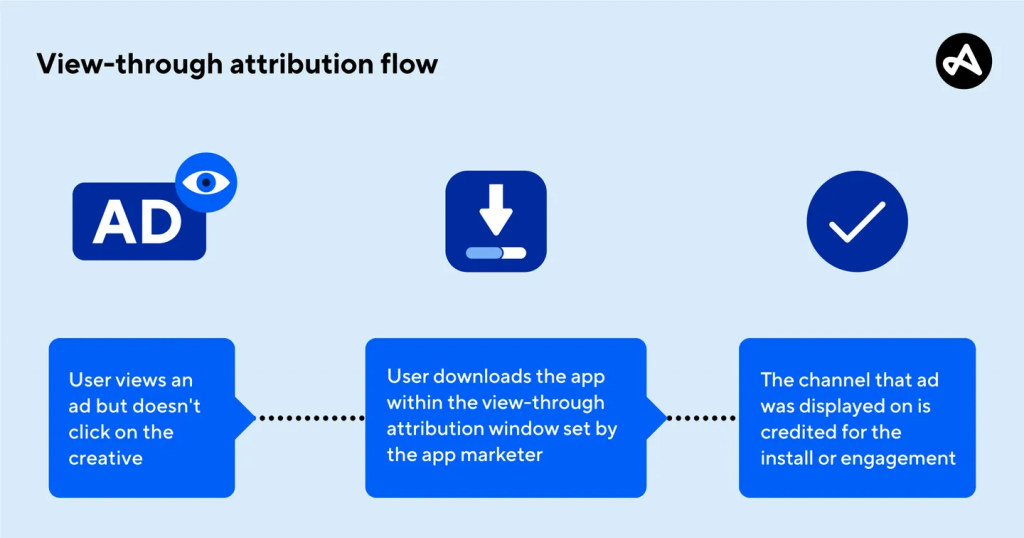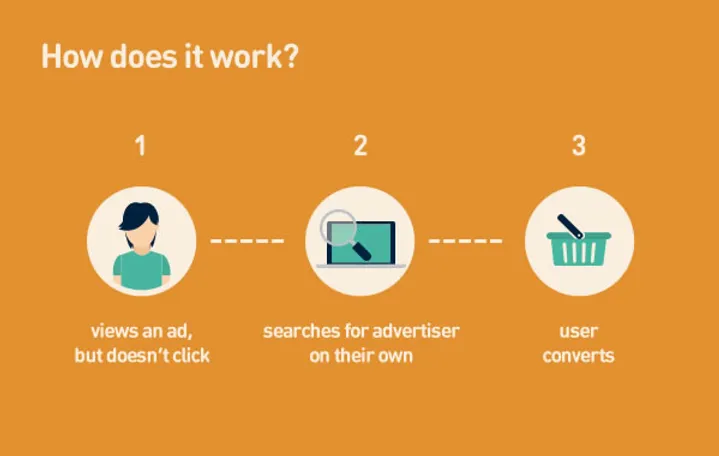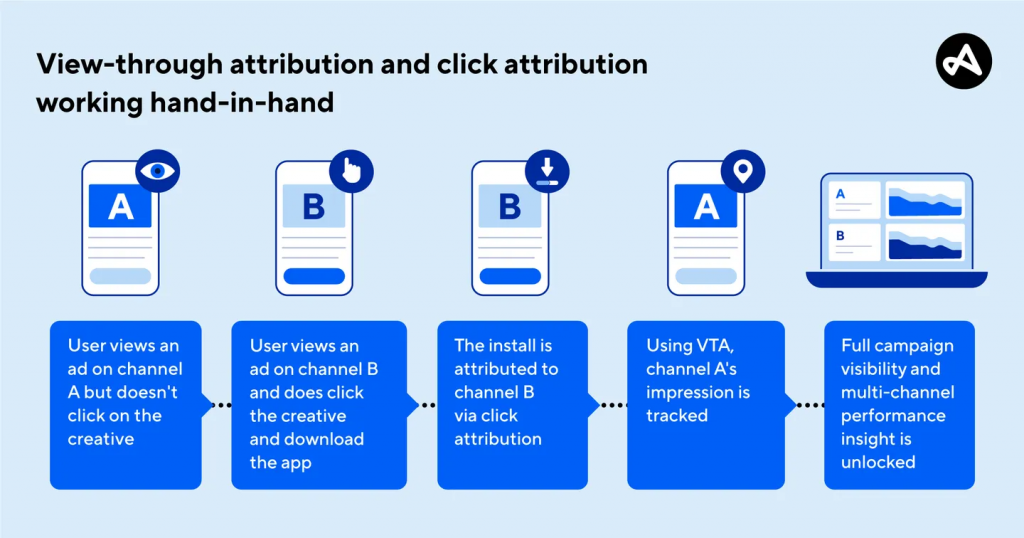What is View-Through Attribution (VTA)? How Does It Differ From CTA?
Reading Time: 7 minutes
Understanding the journey a consumer takes before making a purchase is becoming increasingly intricate. The traditional metrics of clicks and end conversions, while still important, no longer paint the full picture of a campaign’s effectiveness. This is where view-through attribution steps in, offering a deeper insight into the impact of marketing efforts that go beyond direct interactions. With the multitude of channels and touchpoints that consumers interact with today, it’s clear that not all engagements are created equal. Often, the influence of an advertisement is not immediately apparent, as is commonly observed in scenarios where a prospect encounters an ad but does not engage with it right away.
This nuanced approach to attribution is particularly relevant in mobile advertising. In this space, consumers might be exposed to a video ad or banner for an app and, at the moment, decide not to act. However, the seed has been planted, and that initial exposure can lead to a conversion down the line when the consumer chooses to install the app from the app store. View-through attribution recognizes these indirect paths to conversion, attributing success to the initial view of the ad even if the immediate response was non-existent.
The introduction of view-through attribution into the marketer’s toolkit acknowledges the complexity of consumer behavior. It underscores the idea that the effectiveness of an advertisement should not solely be judged by the immediate actions it prompts but also by the lingering influence it holds over consumer decision-making.
What is View-Through Attribution?
View-through attribution (VTA), also known as impression tracking, represents a significant shift in how digital marketing effectiveness is measured. Traditionally, the success of online advertising campaigns has been gauged by direct actions such as clicks and conversions. However, this narrow focus overlooks the subtler, yet equally important, influence of ad impressions on user behavior. VTA offers a more comprehensive approach by acknowledging that not all conversions are the result of direct interactions with an ad.

In digital advertising, a user’s journey from initial ad exposure to eventual conversion can be complex and multifaceted. As mentioned earlier, there are instances where users may see an ad—such as a banner for a new app or a promotional video—but choose not to interact with it immediately. This lack of immediate engagement does not necessarily mean the ad failed to make an impact. On the contrary, the ad might have sparked interest or awareness, laying the groundwork for a future conversion. This is where View-Through Attribution comes into play.
VTA enables advertisers to track these indirect influences by monitoring the initial ad impressions that did not result in immediate clicks. If, within a certain timeframe known as the attribution window, the user takes a desired action (like installing an app or making a purchase), VTA allows that conversion to be attributed back to the original ad impression. This attribution window can vary, often ranging from a few hours to several days, depending on the platform and the specific parameters of the campaign.
This method of attribution is particularly valuable because it provides a more accurate representation of an ad’s overall effectiveness. It acknowledges that the consumer decision-making process is influenced by numerous factors and that the path to conversion is not always linear. By incorporating VTA into their measurement strategies, marketers can gain deeper insights into how visibility and brand awareness contribute to conversions, even when direct interactions are absent.
How does VTA work?
Understanding the mechanics of View-Through Attribution (VTA) requires a deep dive into its core component: the lookback window, or attribution window. This window is pivotal in tracking and attributing conversions that occur after an initial ad impression, bridging the gap between ad exposure and user action. The process begins the moment a user is exposed to an advertisement, marking the start of the attribution window. This timeframe is crucial, as it acknowledges the reality that conversions do not always happen instantaneously. Users might need time to consider their decisions, conduct further research, or simply wait for a more convenient time to complete the action.

The attribution window’s duration is not one-size-fits-all; it is adjustable and can be tailored to match the expected conversion journey for the advertised product or service. This flexibility allows marketers to account for different consumer behaviors and purchase cycles, ranging from impulsive buys to more deliberated decisions that require longer consideration periods. Whether the window is set for 24 hours, 72 hours, or even longer, its purpose is to capture and attribute conversions to the correct ad impression, even if the conversion happens days after the initial exposure.
During this window, the advertising or attribution platform meticulously tracks user interactions. This tracking is not limited to direct engagements like clicks; it extends to monitoring whether the user completes a desired action—such as an app installation or a product purchase—within the set timeframe. If a conversion occurs, the platform then attributes it back to the original ad impression, provided the action falls within the attribution window. This attribution is made possible through the use of cookies, pixels, or mobile identifiers, which help in identifying the user and linking the conversion to the initial ad exposure.
Drawbacks of VTA
While View-Through Attribution (VTA) brings a valuable perspective to assessing advertising effectiveness, it comes with its set of drawbacks that can complicate the analysis and optimization of marketing strategies. A significant challenge is the ambiguity it introduces in attributing the exact impact of each advertising channel on conversions. This issue arises particularly in multi-channel environments where individuals may be exposed to several ads before converting. VTA’s method of crediting all ads viewed within the attribution window can lead to an overestimation of some channels’ effectiveness. Specifically, if a consumer sees multiple ads but only the last ad truly influences their decision to convert, earlier ads are also credited, potentially skewing the data.
Another hurdle with VTA is determining the appropriate length for the attribution window. This decision is critical and can vary significantly depending on the product and the typical consumer journey. An incorrectly set attribution window—either too short or too long—can either overlook actual influenced conversions or mistakenly attribute conversions to an ad that had little to no real impact. This calibration challenge can be particularly daunting for those new to VTA, requiring a deep understanding of consumer behavior that only comes with experience and experimentation.
Moreover, VTA’s reliance on the assumption that ad exposure alone contributes to conversions, even without direct engagement, can lead to assumptions about a campaign’s efficacy that may not hold under scrutiny. This method risks overvaluing campaigns that might not be as effective in driving genuine engagement or conversions, as it lacks direct engagement metrics to confirm the ad’s influence on the conversion process.
To navigate these drawbacks, marketers are encouraged to integrate VTA with other attribution models, such as click-through and multi-touch attribution, to achieve a comprehensive view of their campaigns’ performance. Adjusting the attribution window based on ongoing data analysis and leveraging a mix of qualitative insights and engagement metrics can also provide a more accurate and balanced assessment of advertising effectiveness.
VTA vs CTA
The nuances between View-Through Attribution (VTA) and Click-Through Attribution (CTA) is crucial for marketers and advertisers aiming to accurately measure the impact of their campaigns. CTA, known for its straightforward approach, attributes conversions based on direct interactions—namely, clicks on ads. This model operates under a clear-cut premise: a conversion is only considered to have occurred if it follows a user’s click on an advertisement. The simplicity of CTA’s implementation makes it a favored choice for many marketers, as it directly correlates specific user actions to campaign goals.
On the other hand, VTA introduces a more nuanced and complex model of attribution, which is particularly beneficial in scenarios where direct clicks are not the sole indicators of an ad’s effectiveness. For instance, in industries like mobile app marketing, VTA offers valuable insights by attributing conversions to users who have seen an ad but did not immediately engage with it through a click. This method acknowledges the influence of ad impressions on user behavior over time, providing a broader understanding of how exposure to ads can lead to conversions.

However, the complexity of VTA comes with its challenges, notably the potential for overemphasizing the impact of an ad impression within a prolonged attribution window. If the window is too extensive, there’s a risk that conversions could be incorrectly attributed to an ad that the user saw but that had little to no actual influence on their decision to convert. This issue highlights the importance of carefully setting and regularly reviewing the attribution window in VTA to ensure that it accurately reflects the consumer journey and the ad’s true impact.
In comparison, CTA’s simplicity avoids such complexities, offering a more straightforward interpretation of campaign performance based on direct user actions. However, this simplicity can also be a limitation, as it overlooks the subtler effects of ad exposure that don’t result in immediate clicks but may still contribute significantly to the conversion process over time.
The choice between VTA and CTA depends on the specific needs and goals of a campaign, as well as the nuances of the target audience’s behavior. While CTA offers clear, direct attribution ideal for straightforward conversion paths, VTA provides a deeper dive into the indirect effects of advertising, essential for capturing the full spectrum of how ads influence user behavior. Balancing these two approaches can give marketers a more comprehensive view of their campaign’s effectiveness, enabling more informed decision-making and strategic planning.
Final Thoughts
With complex data at our disposal, understanding the nuances in how we gauge advertising effectiveness, transcending traditional metrics to capture the nuanced impact of ads beyond direct interactions. VTA sheds light on the often-overlooked value of ad impressions, acknowledging the complex journey consumers embark upon before reaching a conversion. This method not only enhances our understanding of consumer behavior but also underscores the importance of considering the broader influence of advertisements.
Despite its advantages, VTA navigates through challenges such as attribution ambiguity and the difficulty in determining the ideal attribution window. These hurdles highlight the need for a balanced approach, combining the insights from VTA with other models like click-through attribution (CTA) to form a comprehensive view of a campaign’s effectiveness. By doing so, marketers can refine their strategies, making informed decisions that cater to the intricate pathways of the consumer decision-making process.
Sell more, understand your customers’ journey for free!
Sales and Marketing teams spend millions of dollars to bring visitors to your website. But do you track your customer’s journey? Do you know who buys and why?
Around 8% of your website traffic will sign up on your lead forms. What happens to the other 92% of your traffic? Can you identify your visiting accounts? Can you engage and retarget your qualified visitors even if they are not identified?
